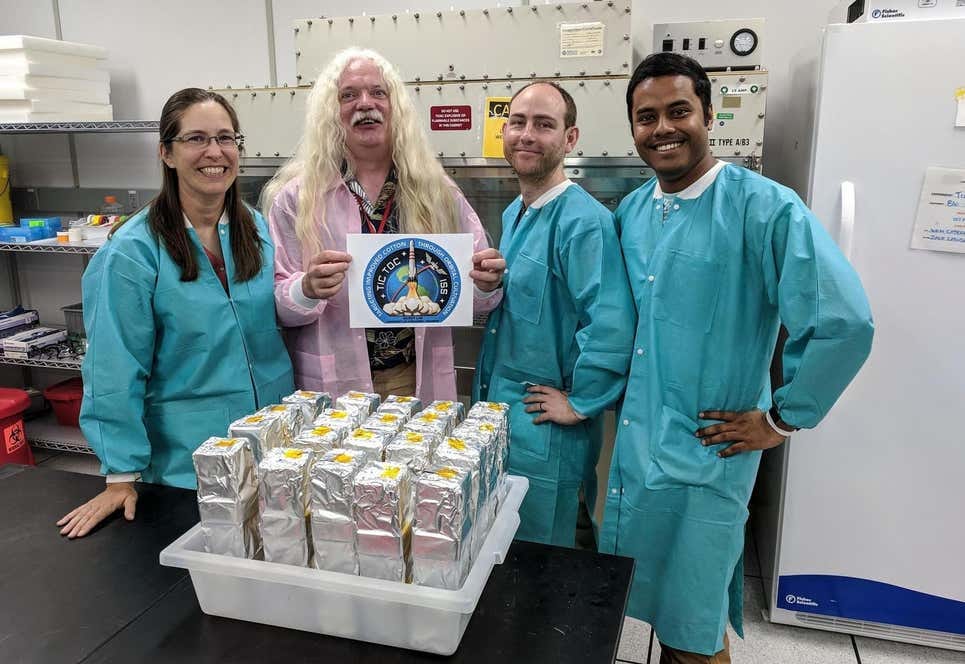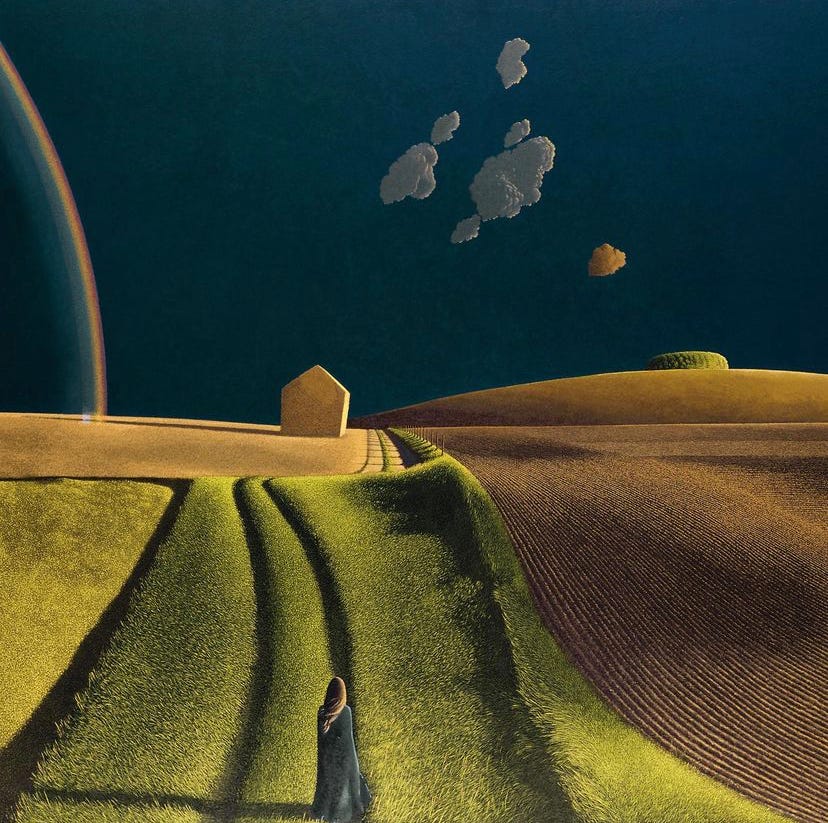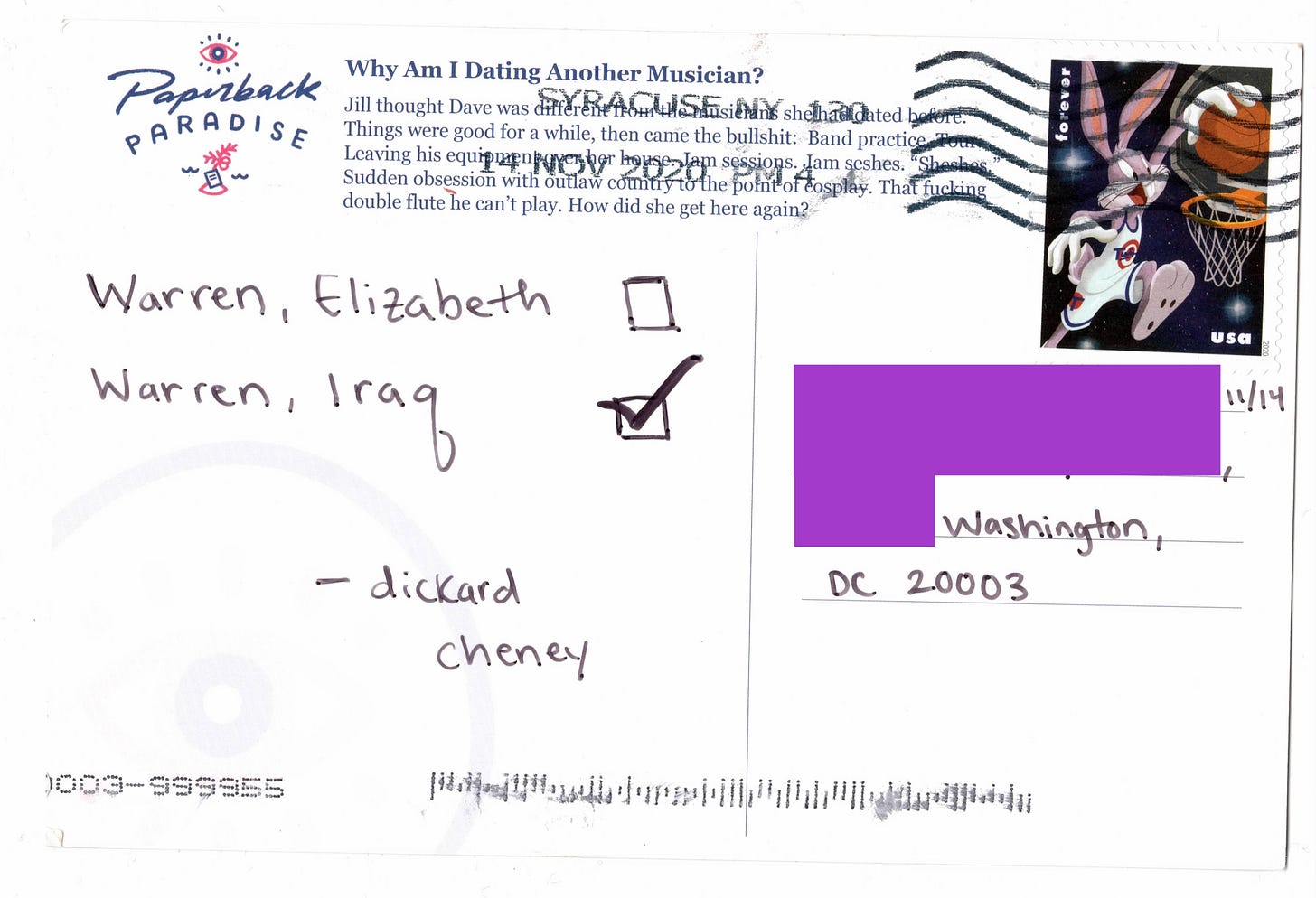dead hot pepper summer
June 8, 2021
Welcome to Reality Farm.
I wrote about 90% of this edition last week, but got spooked and didn’t send it — here it is, gloriously rewritten and exorcised of bad vibes.
Lost? Confused? Excellent, me too. Here’s a map.
SUGAR CUBES 📷
David Inshaw — The Badminton Game (1972-3)
David Inshaw — The Raven (1971)
David Inshaw — She Did Not Turn (1974)
WEATHER REPORT 🖼
It’s finally June. For the first time, I’m harvesting more from my garden than I can use. This poses a problem. It poses a problem because I am harvesting only herbs, and I have an abundance of herbs, and herbs are coming out of my ears. During my disastrous first planting, all of my crop plants, including the green onions, cucumbers, and peppers died — technically, my hot pepper is still alive, but the compassionate thing would be to put it out of its misery. CORRECTION: The hot pepper died overnight, in an apparent “You can’t fire me, I quit” situation.
The only plants that survived the first planting were my herbs: the rosemary, cilantro, and parsley. I’m a sucker for positive reinforcement, so I doubled down on my herbs and am awash with aromatic shrubs. Even though I cook almost every night, I simply cannot use all these herbs. This is partly my own fault. For the first several weeks that the herbs were viable to harvest, I was too precious with them — a recipe would call for cilantro and I’d think, “No. This recipe isn’t particularly good. Not good enough for my cilantro. I will save my cilantro for something special.” Of course, there is no dish special enough for your cilantro, there is only dinner. By the time I learned that lesson, my herbs were overgrown and I needed to harvest them or risk the whole lot rotting into mush.
It’s a daunting experience, to be confronted by a countertop of herbs when you have no real use-case for them, but if you find yourself in my gardening shoes here are some hot tips:
Tell yourself that a food processor will solve most, if not all, of your problems. Ask for one for your birthday. Use the food processor to pulverize your mounds of parsley plus nine store-bought ingredients into a vat of chimichurri. Voilà — 100% organic, farm-to-table chimichurri. You now feel compelled to put the chimichurri on steak, chicken, fish, eggs, salads, pasta, in cocktails and smoothies, wake up and take a shot of chimichurri, one small coffee and leave room for chimichurri, thanks for inviting me over for drinks I’ll bring the chimichurri, Raw Chimichurri Nationalism, 3AM “u up? to eat chimichurri?” text, hot chimichurri summer, vaxxed waxed and chimichaxxed. Familiarize yourself with the law of conservation of parsley: parsley is never created or destroyed, only converted into chimichurri.
Endeavor to pick and use your own cilantro. Once you pick the cilantro, fuss over slight discolorations until you decide to throw it all away and use store-bought cilantro instead.
Rosemary is a useless herb. Do not delude yourself into thinking you will make rosemary ciabatta bread. You planted three rosemary plants because someone said you could make rosemary cocktails and that seemed like a cool and high-status thing to do with your herbs. Do not delude yourself into thinking you will make rosemary cocktails. Use your rosemary to make rosemary-infused olive oil — basically rosemary + olive oil + heat, then strain — and pretend like you didn’t just ruin a bunch of perfectly good olive oil. Feel anxious and vaguely guilty about the quantity of rosemary-infused olive oil. Use it on everything. All your dishes now taste faintly, only faintly, of rosemary.
Sometimes I wonder how it is that I ended up growing a garden of garnishes, then I remember telling people about my garden before I ever planted anything — they only ever ooh’ed and ahh’ed over the herbs I mentioned, never the imaginary cucumbers or tomatoes. Herbs are high status. I sold out. “Do you want to see my basil?” — sexy, might make me a gin basil smash. “Do you want to see my potatoes?” — suspicious, might be an 18th century Irish peasant lost in time.
Other garden developments:
My grandmother has given me three mint plants, despite my insistence that we’re not allowed to grow mint. I have to sneak out every few weeks in the dead of night to dispose of the mint on people’s doorsteps, like I’m abandoning a child.
The hose on the rooftop has broken four times. Every time you turn on the water it sprays brilliantly in unexpected directions and there is no possible way to tend to your plants without looking like you just stepped off a log flume ride at Disneyland.
Someone is uprooting people’s plants and laying them back in the mulch. They aren’t taking anything, just committing garden-variety vandalism, and I sometimes marvel at the inner lives of people.
Other Washington developments:
With the repeal of the mask mandate in the city, I realized that I forgot what a lot of public indoor spaces smell like. That kind of ambient antiseptic je ne sais quoi.
POSTCARDS FROM OUTER SPACE 🎴
WALKING THE FENCELINE 🕸
I follow a Twitter account, Midwest Modern, run an architect in Detroit named Josh Lipnik. Lipnik chronicles mid-century design and other architectural oddities in the Midwest.
I grew up in the Midwest and the photos from Midwest Modern are eerily familiar: all Lutheran churches, crumbling art-deco hotels, abandoned schools and demolished post offices, forgotten Frank Lloyd Wright homes, and statues of Paul Bunyan. The photos stand at the threshold between America’s post-war style and a perception of the Midwest as a place of spiritual death. They are experiments upon the plains. Some buildings sag into the curbs of post-industrial towns, while others stand gleaming in busy metropolises. I wouldn’t believe the photos had I not grown up in the very buildings they depict.
I like the account a lot but occasionally resent it. It kicks off a defensive reflex in my brain. In college, I often heard the Midwest mocked as a backwater. I argued otherwise, and for years this reflex made it hard for me to embrace the Midwest’s peculiarities, for fear of proving the allegations that I was from some sleepy, alien place of no consequence.


UFOs IN THE COW FIELD 🛸
A few days ago, SpaceX launched a resupply mission to the International Space Station (ISS), carrying food for the astronauts as well as the usual bevy of experiments dreamed up by mad scientists (see below, in pink) and funded by American taxpayers.

One of the experiments on this particular flight included a shipment of baby squid. Both my friends working in aerospace and my 👽 Alien Alert 👽 groupchat agreed that this was an extremely bad idea — any idiot who has seen a few science-fiction movies can connect the dots and see how this ends: with mutant squids attacking our astronauts, then piloting the ISS off to the deep and tranquil waters of Europa.
After we got past the inadvisability of sending squids to space, I grew troubled with the injustice of it all — I mean, I’m a red-blooded American with rights and I’ve never been to space. But two dozen baby squids come along and NASA is all, “Sure, go ahead, go right on up.” Do you know what we do with squids in this country? We deep fry them and eat them with marinara sauce. Talk about humiliating. The same species staring up at me from a greasy red-checked paper tray is also cavorting with our planet’s best and brightest in low Earth orbit.
Are squids technically a spacefaring species? If so, what does that make miserable me, left here to peck around in the dirt? I spent a few minutes flipping about in the Merriam-Webster dictionary and think the jury is still out, etymologically speaking, on the spacefaring question, but since I am determined to know my enemies, I turned to Wikipedia to compile a list of all the different animals who went to space before me:
Fruit flies (first animal in space)
Monkeys (Albert II was the first monkey in space. Don’t ask about Albert I.)
Mice
Dogs (the Russians used strays off the streets of Moscow because they figured the dogs had already adapted to extreme cold and hunger)
Rabbits
F̶r̶o̶g̶s̶ (rocket blew up on launchpad)
Rats
Chimpanzees (the oldest chimpanzee in North America died yesterday in the San Francisco zoo at the age of 63, RIP Cobby)
Frogs II (they made it this time)
Guinea pigs
Cats
All manner of insects, flies, and worms
Tortoises (the first inhabitants of Earth to circle the moon) and turtles
Fish (lol)
Spiders
Newts (with amputated limbs, to study regeneration of injuries in space) and geckos
Shrimp
Snails
Jellyfish
Nematodes (found alive in the debris of the Space Shuttle Columbia disaster)
Cockroaches
Scorpions (the cockroaches and scorpions flew on the same flight, Genesis II, widely considered by me to be the most horrifying spaceflight ever)
Tardigrades (the only animal we ever chucked out into open space just to see what would happen) (they survived)
Squid
This is roughly the order in which the animals went up in rockets. I excluded plants, because I will never begrudge a potato for going to space.
+bonus: While we await the UFO report, the NYT scooped the big conclusions:
WASHINGTON — American intelligence officials have found no evidence that aerial phenomena witnessed by Navy pilots in recent years are alien spacecraft, but they still cannot explain the unusual movements that have mystified scientists and the military, according to senior administration officials briefed on the findings of a highly anticipated government report.
The report determines that a vast majority of more than 120 incidents over the past two decades did not originate from any American military or other advanced U.S. government technology, the officials said. That determination would appear to eliminate the possibility that Navy pilots who reported seeing unexplained aircraft might have encountered programs the government meant to keep secret.
But that is about the only conclusive finding in the classified intelligence report, the officials said.
TL;DR: Not ours, could be China, could be Russia, not ruling out aliens.
THE BOOK BARN 📖
Libra by Don DeLillo
(Fiction, 1988. $15.)
“Let me explain about obsessions,” he said.
“Oh yes please.”
“I take a sweeping view of the subject.”
“God yes.”
“It’s the job of an intelligence service to resolve a nation’s obsessions. Cuba is a fixed idea. It is prickly in a way Russia is not. More unresolved. More damaging to the psyche. And this is our job, to remove the psychic threat, to learn so much about Castro, decipher his intentions, undermine his institutions to such a degree that he loses the power to shape the way we think, to shape the way we sleep at night.”
“Maybe what I don’t understand is why Cuba. Do I know the first thing about this island? Is it West Indian, is it Spanish, is it white, is it black, is it mulatto, is it Latin American, is it Creole, is it Chinese? Why do we think it belongs to us?”
“It’s not a question of belongs to us. It’s a question of something working beautifully.”
note: In “Libra”, DeLillo t̶e̶l̶l̶s̶ ̶t̶h̶e̶ ̶G̶o̶d̶-̶h̶o̶n̶e̶s̶t̶ ̶t̶r̶u̶t̶h̶ ̶a̶b̶o̶u̶t̶ imagines a scenario in which Lee Harvey Oswald was recruited by the CIA to assassinate John F. Kennedy, in a bid to spark regime change in Cuba. I finished it last night. Typically, I try to wait a few weeks, forget all about a book, then see if there was anything about the book worth remembering before I recommend it. However, I have this experience with DeLillo where I enormously enjoy his prose, but can’t remember a damn thing about it once I’ve finished the book. I have a theory that it’s a peculiar effect of systems novels, but it might just be a personal problem.
“Libra” is a solid beach read — a compelling story and magnificent book that I’ve already forgotten.
THE RIGHT’S WING 🦇
Saw this on Twitter from @AdamNeumannsCoS. I didn’t know who Huey Long or @shoe0nhead was but otherwise this seems right.









